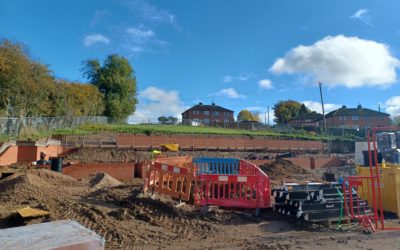How can we make homes more affordable to run?
The current war on Ukraine is rapidly exacerbating an already precarious situation for UK householders needing to heat and power their homes.
Gas prices are reaching record highs, while the cost of living continues to soar. Yet energy prices were rising way before these events, and for many households, heating and powering a home could soon become immensely difficult.
Renewable technologies that use natural power sources, like heat from the sun and the ground, are a key part of the longer-term solution, but equally important are building standards that help to ensure a property can be heated and powered more sustainably.
Making homes more efficient and affordable
Across the county, more and more developers are building with the future in mind. In Shropshire’s new Local Plan policy on minimising carbon emissions, 10% of the predicted energy needs of a new build development must come from on-site renewable and low carbon energy sources.
Not only will this initiative help to reduce the county’s carbon footprint by reducing our reliance on fossil fuels, but it means that the homes being built today will be more energy efficient and cheaper to run. In fact, developments of 10 properties or more will see a 19% improvement on current energy performance.
While these renewables could potentially come from any source – including wind, hydroelectric and biomass – there are three key energy sources that are proving most effective at a domestic level.
Ground Source
Ground source heat pumps work by transferring heat from the ground – which stores warmth from the sun at a few metres below the surface – into a building. Even in the winter months, this below-earth temperature remains at a steady 10c.
This technology has 70% lower carbon emissions than a gas boiler system and can be up to 400% more efficient in terms of electricity usage. The real benefit for homeowners is low running costs, which – when installed and used well – are lower than for any other space heating system – with savings in running costs of between 30% and 70%.
Air Source
Air source heat pumps are a little different. They absorb heat from the air outside into a liquid refrigerant, and use electricity to compress the liquid to release its temperature and release it as stored heat for radiators and underfloor heating systems.
Solar Source
Solar PV, which works by absorbing sunlight into the photovoltaic cells in a solar panel to create electrical charges, is one of the most popular and cost-effective renewable options for domestic and commercial properties. As the government moves towards the new Future Homes Standard, we’ll begin to see more widespread use of solar panels on new build homes as standard.
On a local level, the homes we’re seeing built across Shropshire to address growing housing need are being constructed to higher standards of efficiency than ever before.
One such scheme is STAR’s new development at Weston Rhyn, near Oswestry, which is currently under construction. Aspen Grange is an independent living scheme of 18 apartments and 6 special bungalows, all built to HAPPI standards.
Instead of using carbon-heavy gas boilers – due to be phased out from 2025 – STAR have installed ground source heat pumps to supply heat to all apartments on the development, while the remaining bungalows have a combination of air source heat pumps and solar PV.
Little Stocks Close – a community-led housing scheme in Kinlet, near Bridgnorth – is designed in a similarly efficient way. The development is served by its own bio-disc sewage treatment plan and each property is heated by ground source heat pumps using shared ground arrays, making the homes significantly cheaper to run.
In Whitchurch, the 27 new homes currently being built by Wrekin Housing Trust in Prees will follow similar standards. Each property at the site – which includes houses and bungalows available for Affordable Rent and Shared Ownership – features solar panels and air source heat pumps to minimise future heating and electricity costs for residents.
Building to ‘A’ Energy Ratings can also include smaller improvements such as double glazing, loft insulation and energy saving lightbulbs, but the gold standard of sustainability and energy efficiency is the Passivhaus building principles. In Passivhaus properties, heating costs can be up to 90% cheaper, which makes an enormous difference to reducing fuel poverty.
Tim Baldwin, Affordable Warmth & Energy Efficiency Officer at Shropshire Council, said: “You can actually build properties that don’t need heating systems if you build the fabric correctly. And ultimately, this means building to Passivhaus standards on more plots – not only within Shropshire but nationwide.”
A superb example of the Passivhaus principles in Shropshire is the Callaughtons Ash development in Much Wenlock. It was among the first scheme in the UK to be built to standards that provide super-efficient homes for people in housing need with a strong local connection to the area.
Built from strong timber frames with insulation that effectively seals the house, along with triple glazing, energy efficient boilers, mechanical ventilation with heat recovery (MVHR) systems and thermally modified external cladding, means that the predicted spend on heating and hot water at the time of build in 2018 was around £90 a year for a 3-bedroom house.
Ultimately, these types of technologies will become the only way forward – not only within Shropshire but across the rest of the UK – in terms of securing our energy future.
Resources & Support



